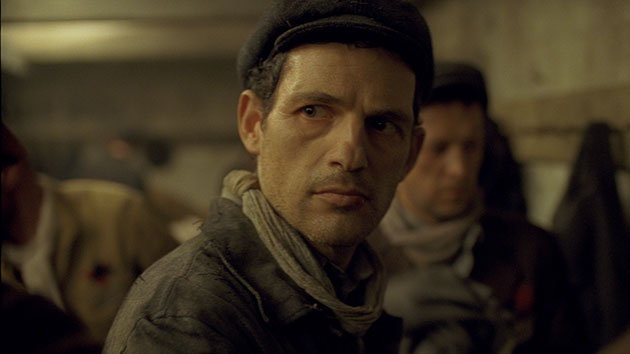The harrowing Son of Saul, a drama that covers a day-and-a-half in the life of Saul Ausländer, a Hungarian Jew being held prisoner in the Auschwitz concentration camp in 1944, is a heavy favorite to win the Best Foreign Language Film Oscar this Sunday night. And even in a year when a number of Oscar nominees were shot on film — The Hateful Eight on 65mm, Carol on Super 16 — director László Nemes' insistence on shooting film stands out.
Not only was the film shot on 35mm by cinematographer Mátyás Erdély, but it was edited and finished photochemically, too. Nemes may have been demanding (he spent two years as an assistant to the master Hungarian director Béla Tarr, which may have something to do with the clarity of his vision), and it was tough to get the film made (anticipated funding from France and other countries fell through and it ended up being a Hungarian coproduction), but its international success vindicates Nemes' particular vision.

Director László Nemes and actor Géza Röhrig; Photo by Ildi Hermann, Courtesy of Sony Pictures Classics
"We … wanted to use traditional 35mm film and photochemical processing at every stage," Nemes said in a statement provided by U.S. distributor Sony Pictures Classics. "It was the only way to maintain a certain instability in the images, and thus be able to film this world organically. The challenge was to strike an emotional chord in the audience — something that digital doesn't allow for."

Left to right: Cinematographer Mátyás Erdély and Géza Röhrig; Photo by Ildi Hermann, Courtesy of Sony Pictures Classics
Nemes, Erdély, and production designer László Rajk decided on certain guidelines before shooting, which the director describes as "a sort of dogma." The film was not to look "beautiful" or "appealing." It could not be a horror film. And the film's point of view could not wander beyond the limited perspectives of Saul himself.

Photo by Ildi Hermann, Courtesy of Sony Pictures Classics
According to a blog post by Kodak's Motion Picture Film division, Son of Saul was filmed with ARRICAM LT and ARRIFLEX 235 cameras loaded with Kodak Vision3 500T Color Negative Film 5219. The film was shot through 35mm and 40mm lenses with simple, diffused lighting and the squarish, 1.37:1 aspect ratio of early film history. The camera follows the protagonist closely, with a tight point of view, throughout.
In the film's production notes, Nemes observes that the red target on the back of Saul's jacket was meant to make it easier to shoot escapees from the camp. For Son of Saul, he says, it served as "a visual target for the camera."
Once the look had been set on film (with color timer Viola Regéczy) for creating the 35mm "show prints" that would play on the festival circuit, digital colorist László Kovács at Budapest post-production facility Hungarian Filmlab (Magyar Filmlabor) was faced with the task of translating that precise look to a digital environment for creating a DCP and theatrical release prints. Filmlight said the 35mm camera negative was digitized at 4K on a FilmLight Northlight scanner, creating a high-resolution master for producing both 35mm prints and 2K DCP files. The digital color grade took place in a FilmLight Baselight Four suite, where Kovács used traditional color-timing techniques to digitally match the look that Nemes and Erdély had approved on film.

Left to right: Christian Harting as Oberscharführer Busch and Géza Röhrig as Saul; Courtesy of Sony Pictures Classics
"Even in the DI, we mainly used primary color-correction," said Erdély in a statement provided by FilmLight. "We wanted to limit ourselves to the most essential tools." For this project, it was critically important that the 35mm and digital deliverables were a perfect match.
Did you enjoy this article? Sign up to receive the StudioDaily Fix eletter containing the latest stories, including news, videos, interviews, reviews and more.


Leave a Reply